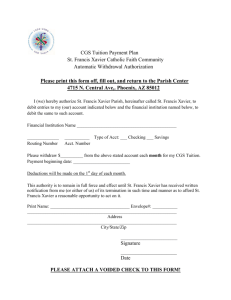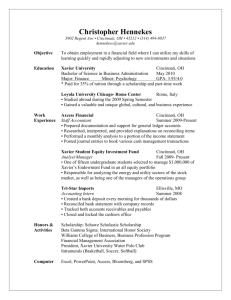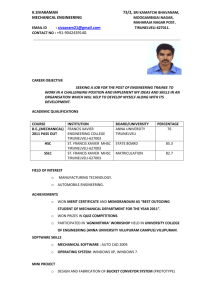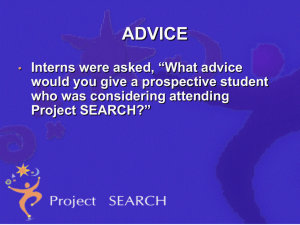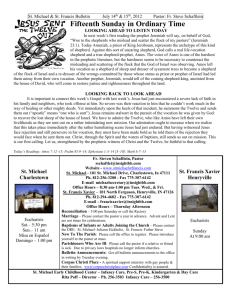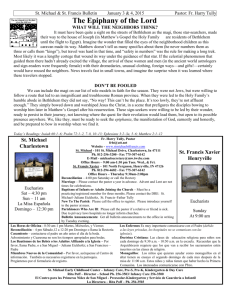Preparing a Good Research Paper
advertisement
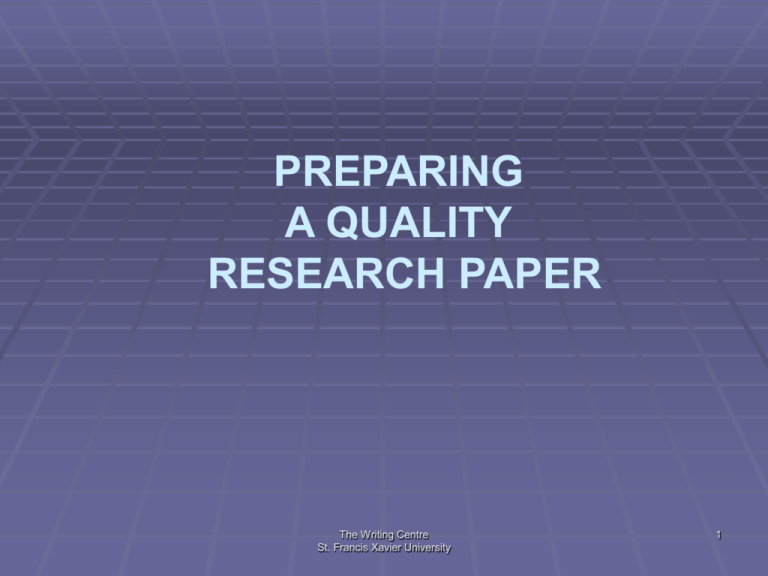
PREPARING A QUALITY RESEARCH PAPER The Writing Centre St. Francis Xavier University 1 Topics Planning / Pre-writing Essay Structure Presenting Your Ideas Writing Mechanics Documenting The Writing Centre St. Francis Xavier University 2 Planning / Pre-writing The Writing Centre St. Francis Xavier University 3 Planning / Pre-writing Assignment – Music 118 – World Music FEBRUARY Due date: March 30 S M T W T F S F S 2 Start time management plan now. 8-10 pages (2000-2500 words) Try this website to help manage your work: http://www.lib.umn.edu/help/calculator/ 9 16 23 SPRING BREAK MARCH S M T W T 1 8 15 22 29 The Writing Centre St. Francis Xavier University 4 Planning / Pre-writing Choosing your topic READ the assignment details. Make sure you understand the terminology. Question, question, question. Look at all the options. Narrow down choices. The Writing Centre St. Francis Xavier University 5 Planning / Pre-writing Choosing Your Topic Questioning: Ask yourself… Why did I pick this particular topic? What do I know about this subject? What do I need to find out? What resources are available? The Writing Centre St. Francis Xavier University 6 Planning / Pre-writing Information Gathering Read the appropriate sections in your text. Read recommended readings. Search for relevant information and then research. Use the library. Use the electronic library. The Writing Centre St. Francis Xavier University 7 Planning / Pre-writing Outlines - Organizing your information Sub-Point Main Point: Main Point Sub-Point • Sub-Point • Sub-Point • Sub-Point Sub-Point The Writing Centre St. Francis Xavier University 8 Planning / Pre-Writing Sub-point Sub-point Sub-point Main point Main Idea of Your Essay Main point Main point The Writing Centre St. Francis Xavier University 9 Planning / Pre-writing Outlines - Organizing your information Main Idea of your Essay Main Point (1) Sub-Point Sub-Point Sub-Point Main Point (2) Sub-Point Sub-Point Sub-Point Main Point (3) Sub-Point Sub-Point The Writing Centre St. Francis Xavier University 10 Planning / Pre-writing Critical Thinking About Your Topic Ask yourself questions as you go through the information gathering process. Constantly integrate ideas from research into your essay plan. Be analytic. Break down general ideas into sub-points. Are your points specific enough to your main idea? Is your outline realistic for your page limit: 8 – 10 pages? The Writing Centre St. Francis Xavier University 11 Planning / Pre-writing Supporting Your Arguments Back up what you say with evidence. Keep accurate references as you research and take notes. Be sure to put quotation marks around any copied information. Do not plagiarize The Writing Centre St. Francis Xavier University 12 Essay Structure The Writing Centre St. Francis Xavier University 13 Essay Structure Introduction Sub point Sub point Sub point Thesis Statement Main point Main Idea Main point Main point The Writing Centre St. Francis Xavier University 14 Conclusion Essay Structure Introductions Start with general information specific to your topic. This is often background information that provides context and helps to set up your main idea or argument. The Writing Centre St. Francis Xavier University 15 Essay Structure Introductions Begin your paper as clearly and concisely as possible. Define important terms. Explain concepts the reader will need in order to understand the rest of your paper. The Writing Centre St. Francis Xavier University 16 Essay Structure Thesis Statement Develop a working thesis statement. This is a starting point and will be edited. The Writing Centre St. Francis Xavier University 17 Essay Structure Thesis Statement The main idea and focal point of the entire paper. More than a statement of fact. Identifies what you are arguing, comparing, or challenging Points the reader to the arguments or information found in your paper. Typically is made towards the end of your introduction. The Writing Centre St. Francis Xavier University 18 Essay Structure Simple (working) Thesis Statement: Make a statement Defend / support your statement _________________________BECAUSE 1)___________________________ 2)___________________________ 3)___________________________ The Writing Centre St. Francis Xavier University 19 Essay Structure Simple (working) Thesis Statement: Make a statement: The federal government policy on health care spending is inadequate BECAUSE Defend / support your statement: 1) There isn’t enough money being spent 2) The provinces don’t have the capacity to pay for all needed services 3) Individual provinces are getting around universal access requirement by charging user fees 4) Not enough skilled health care workers are entering the workforce The Writing Centre St. Francis Xavier University 20 Essay Structure Revised Thesis Statement: Federal government policy on health care has failed to address the needs of Canadians for medical services. Not only is there an inadequate federal financial contribution to health care, but there are not enough health care workers to adequately staff our health facilities and individual provinces are allowing physicians to charge user fees. The Writing Centre St. Francis Xavier University 21 Essay Structure Body of the Essay The body of the essay is the presentation of your main points and supporting evidence / arguments in paragraph format. IF you have developed a detailed outline, the structure you have created should lead directly to paragraph topics. The Writing Centre St. Francis Xavier University 22 Essay Structure Conclusions Reiterate your most important points (summarize) and provide insight on your topic. The Writing Centre St. Francis Xavier University 23 Essay Structure Conclusions Insights: If you have pointed out problems throughout your paper, propose possible solutions. Reflect on what have you learned from your paper. Identify some future perspectives. Think beyond the scope of what you have discussed. Try to end on a positive note, and look toward the future. The Writing Centre St. Francis Xavier University 24 Essay Structure Introduction Equal Length Equal Strength Conclusion The Writing Centre St. Francis Xavier University 25 Presenting Your Ideas The Writing Centre St. Francis Xavier University 26 Presenting Your Ideas The First Draft The purpose of the first draft is to identify what information you have, to begin writing and to find where there are gaps in the information supporting your main points. Follow the blueprint you have created. Begin writing in detail. Don’t worry about the specifics of grammar & punctuation. The Writing Centre St. Francis Xavier University 27 Presenting Your Ideas Essential Components of Every Paragraph Make a point (topic sentence). Support or defend your statement (fact or opinion). Ask yourself - Why is this information so important to your point and this paper? Incorporate examples. Quote or paraphrase. Provide logical transitions going from paragraph to paragraph. The Writing Centre St. Francis Xavier University 28 Presenting Your Ideas 2nd and Subsequent Drafts Revise for : Clarity in terms of meaning Logical consistency in ideas Addition of supporting evidence Proper documenting More appropriate transitions Refer back to your thesis statement and modify it if your research takes you somewhere you didn’t expect in terms of your main idea or subsequent ideas. The Writing Centre St. Francis Xavier University 29 Writing Mechanics The Writing Centre St. Francis Xavier University 30 Writing Mechanics Clarity Choose words with definite meaning. Use a good dictionary and a thesaurus often. Clarify comparatives – If you are using the words “more’” “less,” “greater,” “better,” always make sure it is clear what you are comparing. Clarify references when using pronouns (him, her, its etc.). Make sure it is clear to the reader what person, place or thing the pronoun is referring to. The Writing Centre St. Francis Xavier University 31 Writing Mechanics Clarity Keep things simple. Say exactly what you mean. Eliminate redundancies and the repetition of ideas using different words. The Writing Centre St. Francis Xavier University 32 Writing Mechanics Forcefulness Use active language. Zero in on the main point you want to make. When possible eliminate empty words such as It is, There is, There are. Example: There are many ways to describe the colours used by Coleridge. They are ….. Change to: Coleridge uses colour to create a variety of moods in the reader. Red, for example…. The Writing Centre St. Francis Xavier University 33 Writing Mechanics The Most Common Major Errors in University Level Writing (From The Writing Centre, Ryerson University) The Writing Centre St. Francis Xavier University 34 …Subject-Verb Agreement Writing Mechanics These tend to occur if the subject is separated from the verb by some descriptive words. Error: The process of sinking these caissons were begun by clearing unstable soil. Process, not caissons, is the subject of were begun. Corrected: The process of sinking these caissons was begun . . . If you make this kind of mistake, start checking every sentence in which the verb does not immediately follow the subject, and every sentence beginning with the word ‘there.’ Error: In 1820 there was new plans proposed. Plans, not there, is the subject of was proposed. Corrected: In 1820 there were new plans proposed for the site. The Writing Centre St. Francis Xavier University 35 …Sentence Fragment Writing Mechanics Part of a sentence is punctuated as a complete sentence. Error: During this time, when the final choice of a computer system is made. “What happens? The word “when” makes the sentence incomplete.” Corrected: During this time the final choice of a computer is made. “You may also correct this by finishing the incomplete sentence.” Corrected: During this time, when the final choice of a computer system is made, you should consult with all the potential users. Error: They came with a proposal. A proposal too good to refuse. Corrected: They came with a proposal, a proposal too good to refuse. You want to keep the emphasis, but “A proposal too good to refuse” has no active verb, and should not be written as a sentence in formal writing. The Writing Centre St. Francis Xavier University 36 Writing Mechanics …Comma Splice or Run-on Sentence Two separate sentences are joined with a comma, or run together without any punctuation. Error: The new buildings would be expensive, the estimated cost of renovating existing offices was half as much. There are 2 separate sentences here, joined with the comma. Split them up, or join them with a conjunction like and, but, or, or a semi-colon (;). If the comma was not there, you would have a run-on sentence error. Corrected: The new buildings would be expensive. The estimated cost of renovating existing offices was half as much. Corrected: The new buildings would be expensive and the estimated cost of renovating existing offices was half as much. The Writing Centre St. Francis Xavier University 37 Writing Mechanics …Misuse of the Semi-Colon The semi-colon (;) joins two sentences into one, without an and or but. This can be a very effective construction, but you must have a complete sentence on either side of the ; Therefore and however frequently begin the second sentence. Error: In 1886, 36,000,000 tons of cargo moved through the St. Lawrence Seaway; in contrast to the average of 11,000,000 tons in the 1950’s. The portion after the ; is not a complete sentence; replace the ; with a comma or change the second part (as suggested below). Corrected: In 1886, 36,000,000 tons of cargo moved through the St. Lawrence Seaway; in contrast, an average of only 11,000,000 tons moved through in the 1950’s. The Writing Centre St. Francis Xavier University 38 Writing Mechanics …Dangling Modifier This occurs when a sentence begins with a verb form ending in -ing or -ed (with or without “By” or “In” or “When,” or other prepositions or conjunctions, in front of it). This -ing or -ed word should refer to the subject of the sentence, which will usually follow the comma. Error: By spending time with their children in play, the children can develop their language ability. Spending is left dangling, as it is not the children who are spending time and there is no other word in the sentence that spending could refer to. Corrected: By spending time with their children in play, parents can help them develop their language ability. It is the parents who are spending the time. . . The Writing Centre St. Francis Xavier University 39 …Word Confusion Some common examples Writing Mechanics where / were eg. Where are you? They were angry. there / their eg. There is. . . Put it there. They argued their case. Hint: Remember where and there both refer to place and both have the same ending. Then / than eg. Then she went to the store. (indicating time) eg. He is faster than his friend. (indicating comparison) its / it’s eg. It’s not right it’s = it is The ‘ means a letter omitted. eg. The dog found its bone. Hint: Think of his, her, its as a group. (No apostrophe.) too / to eg. He came too. (also) It was too late. (comparative) eg.Try to sleep. Go to the store. would have / would of eg. I would have come. Would of doesn’t exist. It’s just our slurring of have when we speak. The Writing Centre St. Francis Xavier University 40 Writing Mechanics Editing for Grammar, Spelling and Punctuation Try to leave time between finishing your paper and proofreading it. Read your essay aloud. A proofreader’s trick: read your sentences, one at a time, starting from the end of the essay and working backwards. This helps you to read what you have actually written, rather than what you meant to write. The Writing Centre St. Francis Xavier University 41 Writing Mechanics Editing for Grammar, Spelling and Punctuation You can use the word-processor’s SEARCH key to check every occurrence of the words that give you problems (eg. it’s/ its, or their/ there). Use the spell check, of course, but always do a final read. Spell check doesn’t necessarily pick up mistakes in appropriate word use. The Writing Centre St. Francis Xavier University 42 Documenting The Writing Centre St. Francis Xavier University 43 Documenting Each documenting style sets guidelines for: The format of your paper In-text citations A reference page for the end of the paper The Writing Centre St. Francis Xavier University 44 Documenting Why do you have to document? To support the points you have made in your paper and acknowledge the source of your ideas To provide references for your reader To eliminate any chances of plagiarizing The Writing Centre St. Francis Xavier University 45 Documenting Modern Languages Association (MLA) Style Some websites that will help you understand the basics of MLA Style: http://www.stfx.ca/people/writingc/ (The Writing Centre / Resources / Documenting Sources) http://www.csustan.edu/english/reuben/pal/append/AXI.H TML http://www.lib.ohiostate.edu/guides/mlagd.html http://www.lib.duke.edu/libguide/works_cited.htm The Writing Centre St. Francis Xavier University 46 Documenting MLA guidelines for in-text citations (Author’s last name page number) (Smith 253) The Writing Centre St. Francis Xavier University 47 Quotation Example The company manager “was obeyed, yet he inspired neither love nor fear, nor even respect” (Conrad 87). Conrad describes the company manager: “He was obeyed, yet he inspired neither love nor fear, nor even respect” (87). “He was obeyed,” writes Joseph Conrad of the company manager in Heart of Darkness, “yet he inspired neither love nor fear, nor even respect” (87). The Writing Centre St. Francis Xavier University 48 Documenting Block Quotations Place quotations longer than four typed lines in a freestanding block of typewritten lines, and omit quotation marks. Start the quotation on a new line, indented one inch from the left margin, and maintain double-spacing. Your parenthetical citation should come after the closing punctuation mark. When quoting verse, maintain original line breaks. The Writing Centre St. Francis Xavier University 49 Documenting Block Quotation - Example In "Sources," Adrienne Rich explores the roles of women in shaping their world: The faithful drudging child, the child at the oak desk whose penmanship, hard work, and style will win her prizes, becomes the woman with a mission, not to win prizes but to change the laws of history. (23) The Writing Centre St. Francis Xavier University 50 Documenting Indirect Quotation Sometimes you may have to use a quotation that you did not find in the original source. Use "qtd. in" to indicate the actual source you found it in. Ravitch argues high schools are pressured to act as "social service centers, and they don't do that well" (qtd. in Weisman 259). High schools are pressured to act as "social service centers, and they don't do that well" (Ravitch qtd. in The Writing Centre Weisman 259). St. Francis Xavier University 51 Paraphrase Example Documenting “We are now in the midst of a technological revolution that is full of surprises. No one thirty years ago was aware that one day household computers would become as common as dishwashers. And those of us who used the old Arpanet of twenty years ago had no idea that it would evolve into the Internet” (Searle 37). 1) Plagiarism: The current technological revolution is surprising. Thirty years ago no one expected computers to be as common today as air conditioners. What once was the Arpanet, has evolved into the Internet and no one expected that. THIS MUST BE DOCUMENTED AS SEARLE’S IDEA 2) Quotation, Paraphrase and Documentation (Properly attributed) John Searle states that we are in a surprising technological revolution in which computers have “become as common as dishwashers” (37). Twenty years ago no one could have predicted the Arpanet would become the Internet (Searle 337). The Writing Centre St. Francis Xavier University 52 Documenting Works Cited List A list of only the works that you “cite,” or refer to in your paper Authors' names are inverted (last name first) If a work has more than one author, invert only the first author's name, follow it with a comma, then continue listing the rest of the authors. The Writing Centre St. Francis Xavier University 53 Documenting Works Cited List All references should be double-spaced. Any references spanning more than one line must appear as a hanging indented paragraph Underline or italicize titles of books, journals, magazines, newspapers, and films. Use quotation marks around the titles of articles in journals, magazines, and newspapers. Also use quotation marks for the titles of short stories, book chapters, poems, and songs. The Writing Centre St. Francis Xavier University 54 Planning / Pre-writing 158 2004 2 3 20040304 20040302 20040228 20040214 20040208 20040207 20040206 004 0 0040204 Subject: Music Starting on: Ending on: 2/2/2004 3/30/2004 According to the dates you have entered, you have 56 days to finish. The Writing Centre St. Francis Xavier University 55 By Wed Feb 04, 2004: Understand your assignment • Suggestions for understanding assignment sheets By Fri Feb 06, 2004: Select and focus topic • Refine your topic • How to begin By Sat Feb 07, 2004: Write working thesis • Definition: Thesis Statements and Research Questions • Sample thesis statements By Sun Feb 08, 2004: Design research strategy • QuickStudy: Designing a research strategy The Writing Centre • AskUs at the Libraries can also help St. Francis Xavier University 56 By Sat Feb 14, 2004: Find, review, and evaluate books • Keep careful notes, with source clearly indicated • Search the library's catalog • QuickStudy: Finding Books By Sat Feb 14, 2004: Find, review, and evaluate books • Keep careful notes, with source clearly indicated • Search the library's catalog • QuickStudy: Finding Books By Sat Feb 28, 2004: Find, review, and evaluate journal/magazine/newspaper articles • Keep careful notes, with source clearly indicated • QuickStudy: Finding Articles • Research QuickStart • Look up articles in an appropriate The Writing Centre index St. Francis Xavier University 57 By Thu Mar 04, 2004: Outline or describe overall structure • Starting a Writing Project • Help with planning your structure By Tue Mar 09, 2004: Write 1st draft • Writing Your First Draft • Online Writing Center at the U of M • CLA Student Writing Center in Lind Hall By Mon Mar 15, 2004: Conduct additional research as necessary • QuickStudy: Evaluating Sources • 'Ask Us' at the University Libraries The Writing Centre St. Francis Xavier University 58 By Fri Mar 26, 2004: Revise & rewrite • Revising Your Work • Online Writing Center at the U of M • CLA Student Writing Center in Lind Hall By Tue Mar 30, 2004: Put paper in final form • QuickStudy: Citing Sources • Proofreading Strategies • The Elements of Style - William Strunk, Jr. • Strategies for Improving Sentence Clarity The Writing Centre St. Francis Xavier University 59
